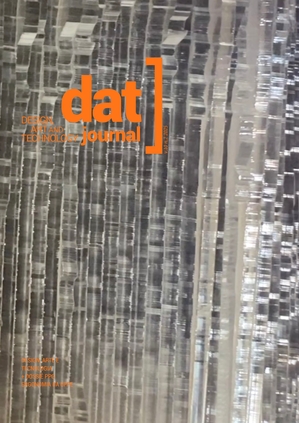Perspectives on the Use of Artificial Intelligence in the Design of Digital Interfaces for Complex Systems
DOI:
https://doi.org/10.29147/datjournal.v10i2.1019Keywords:
Artificial Intelligence, Human-Computer Interaction, Complex Systems, Interface Design, Human FactorsAbstract
Artificial Intelligence (AI) has driven significant transformations in the field of Human-Computer Interaction (HCI), particularly in the design of digital interfaces for complex systems. This article investigates how AI has been applied to make interfaces more adaptive, intelligent, and responsive to dynamic and unpredictable usage contexts. An integrative literature review was adopted as the methodological approach, focusing on studies that describe practical applications, advantages, and limitations of AI in interaction design. The findings highlight a growing range of solutions based on recommended systems, conversational agents, assisted design tools, and adaptive interfaces. It is concluded that, while promising, the integration of AI into interface design requires interdisciplinary and ethical approaches that align computational capabilities with the core principles of HCI.
Downloads
References
IIDA, I. Ergonomia: projeto e produção. 2 ed. São Paulo: Blucher, 2005.
AMERSHI, S. et al. Guidelines for human-AI interaction. In: CHI Conference on Human Factors in Computing Systems, 2019, Glasgow. Proceedings [...]. New York: ACM, 2019. DOI: https://doi.org/10.1145/3290605.3300233
CARAYON, P. et al. Work system design for patient safety: the SEIPS model. Quality and Safety in Health Care, 15(Suppl 1), i50–i58, 2006. DOI: https://doi.org/10.1136/qshc.2005.015842
DEKKER, S. Drift into failure: From hunting broken components to understanding complex systems. Ashgate, 2011.
DUL, J.; WEERDMEESTER, B. Ergonomia prática. 3. ed. São Paulo: Blucher, 2012.
GONZÁLEZ, S.; SAURIN, T. A. Princípios para Gestão de Procedimentos em Sistemas Sócio-Técnicos Complexos. Revista Ação Ergonômica, vol.8, n1, p.48-62, 2013.
GOODFELLOW, I.; BENGIO, Y.; COURVILLE, A. Deep Learning. MIT Press, 2016.
GOROKHOV, V. L.; KHOLODNYAK, D. V. Innovation Complexity - a New Paradigm for Cognitive Ergonomics. In:Third International Conference on Human Factors in Complex Technical Systems and Environments (ERGO)s, Saint Petersburg, 2018. DOI: https://doi.org/10.1109/ERGO.2018.8443910
LEE, J. D.; SEE, K. A. Trust in automation: Designing for appropriate reliance. Human Factors, 46(1), 50–80, 2004. DOI: https://doi.org/10.1518/hfes.46.1.50.30392
HOFFMAN, R. R.; KLEIN, G. Explaining explanation, part 1: Theoretical foundations. IEEE Intelligent Systems, 32(3), 68–73, 2017. DOI: https://doi.org/10.1109/MIS.2017.54
HOLLNAGEL, E. The ETTO principle: Efficiency–Thoroughness Trade-Off. Ashgate, 2009.
KARWOWSKI, W. A Review of Human Factors Challenges of Complex Adaptive Systems: Discovering and Understanding Chaos in Human Performance. In: 18th Triennial Congress of the International Ergonomics Association. Human Factors, 2012. p. 983-995. DOI: https://doi.org/10.1177/0018720812467459
PEREIRA, R.; DARIN, T.; SILVEIRA, M. S. Reflexões da Comunidade Brasileira de IHC. In: Simpósio Brasileiro sobre Fatores Humanos em Sistemas Computacionais (IHC). SBC, 2024. p. 262-360. DOI: https://doi.org/10.5753/ihc_estendido.2024.245469
PICARD, R. W. Affective Computing. MIT Press, 1997. DOI: https://doi.org/10.7551/mitpress/1140.001.0001
LEPLAT, J. Quelques aspects de la complexité en Ergonomie. Em: Daniellou F. –L’ergonomie em quête de ses principes. Octares ed. Toulouse, 57- 76, 1992.
MAZZONI, C. F.; CAMPOS, M. V. G.; PETRY, F. O. Ergonomia que transforma: sistêmica, participativa e integrativa. In: XX Congresso Brasileiro de Ergonomia, virtual, 2020.
MITCHELL, T. M. Machine Learning. McGraw-Hill. Portland: Book News, 1997.
NORMAN, D. A. The Design of Everyday Things: Revised and Expanded Edition. Basic Books, 2013.
READ, G. J. M.; SALMON, P. M.; THOMPSON, J.; McCLURE, R. Simulating the behaviour of complex systems: Computational modelling in ergonomics. Ergonomics, 2020. DOI: https://doi.org/10.1080/00140139.2020.1786263
RUSSELL, S.; Norvig, P. Artificial Intelligence: A Modern Approach (4th ed.). Pearson, 2021.
SHERIDAN, T. B.; PARASURAMAN, R. Human-automation interaction. Reviews of Human Factors and Ergonomics, 1(1), 89–129, 2005. DOI: https://doi.org/10.1518/155723405783703082
SHNEIDERMAN, B. Human-Centered AI. Cambridge: MIT Press, 2022. DOI: https://doi.org/10.1093/oso/9780192845290.001.0001
SANTA ROSA, J. G.; PEREIRA JÚNIOR, A.; LAMEIRA, V. Neurodesign: o cérebro e a máquina. 2. ed. Rio de Janeiro: Rio Books, 2021.
SANTOS, E. F. Ergonomia e Novas Tecnologias. Editora VirtuOS, 2025.
SOUZA, M. T; SILVA, M. D; CARVALHO, R. Revisão integrativa: o que é e como fazer. Einstein (São Paulo), v. 8, p. 102-106, 2010. DOI: https://doi.org/10.1590/s1679-45082010rw1134
WISNER, A.; SZELWAR, L. I. Questões epistemológicas em ergonomia e em análise do trabalho. In: DANIELLOU, F. (Org.). A ergonomia em busca de seus princípios: debates epistemológicos. São Paulo: Blucher, 2004. p. 29-56.
WOODS, D. D. The risks of autonomy: Doyle’s catch. Journal of Cognitive Engineering and Decision Making, 10(2), 131–133, 2016. DOI: https://doi.org/10.1177/1555343416653562
Downloads
Published
How to Cite
Issue
Section
License
Copyright (c) 2025 DAT Journal

This work is licensed under a Creative Commons Attribution 4.0 International License.


























